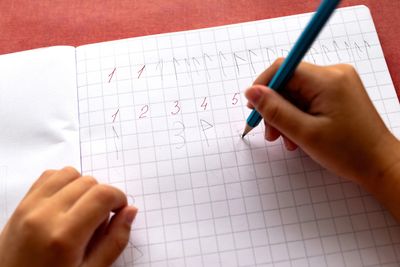DYSGRAPHIA

Supporting Students with Dysgraphia
Dysgraphia is a learning disability that affects writing skills, including handwriting, spelling, and organizing thoughts on paper. Students with dysgraphia may have difficulty with fine motor coordination, processing written language, or both. With targeted support and accommodations, these students can thrive in the classroom. When considering how to best support a student with dysgraphia, ask the following:
What level of individualized support will this child need?
- Collaborate with parents, teachers, and specialists to develop an Individualized Education Plan (IEP) or 504 Plan.
- Include accommodations such as allowing typing instead of handwriting, providing extra time for written assignments, and reducing the volume of written work.
- Assess specific challenges (e.g., motor control, spelling, or organization) to tailor interventions effectively.
What specific challenges does the student face with writing?
Handwriting and Fine Motor Skills:
- Students may struggle to form letters legibly, maintain consistent spacing, or write at an age-appropriate speed.
- Incorporate activities to strengthen fine motor skills, such as tracing, hand exercises, or using tools like pencil grips.
Spelling and Word Retrieval:
- Difficulties with spelling may lead to frustration or avoidance of writing tasks.
- Allow the use of spell-check tools, word banks, or phonics-based interventions to support spelling skills.
Organization and Expression:
- Students may find it hard to organize their thoughts or express ideas clearly in writing.
- Use graphic organizers, outlines, and structured templates to help with prewriting and organization.
How can classroom instruction be adapted?
- Multi-Sensory Approaches: Use tactile or visual aids, such as sand trays or letter tiles, to practice letter formation.
- Assistive Technology: Provide access to word processors, voice-to-text software, or apps like Grammarly to assist with writing tasks.
- Chunking and Scaffolding: Break down writing assignments into smaller, manageable steps with clear, incremental goals.
How will assessments be adjusted for this student?
- Offer alternative assessment formats, such as oral presentations, multiple-choice tests, or project-based evaluations, to demonstrate knowledge without relying on written output.
- Allow extended time for written assignments and tests to reduce pressure and support focus.
What tools and materials will support the student?
- Handwriting Tools: Use wide-ruled paper, slanted desks, or adaptive grips to improve handwriting mechanics.
- Typing Support: Teach keyboarding skills early and provide access to computers or tablets for completing assignments.
- Templates and Organizers: Offer pre-made writing templates, sentence starters, and graphic organizers to help structure ideas.
How can day-to-day activities be adjusted for success?
- Provide frequent breaks during writing tasks to reduce fatigue.
- Encourage collaborative work where peers can assist with note-taking or brainstorming.
- Offer positive reinforcement and focus on progress rather than perfection to build confidence.
Are parents and teachers prepared for frequent and open communication?
- Share regular updates on the student’s progress and successful strategies in the classroom.
- Collaborate with parents to reinforce fine motor activities or organizational strategies at home.
How can faith and values support the student?
- Emphasize patience, perseverance, and understanding in the school community. Celebrate the student’s strengths and contributions beyond their writing difficulties.
- Provide opportunities for the student to participate fully in religious activities, using accommodations like verbal prayers or typed submissions.
Are staff equipped with training on dysgraphia?
- Provide professional development opportunities to help teachers recognize and address dysgraphia.
- Share resources on handwriting instruction, assistive technology, and inclusive classroom practices.
Accommodations and Resources
Instructional Accommodations:
- Allow use of laptops or tablets for writing assignments.
- Provide access to voice-to-text tools (e.g., Google Docs Dictation, Dragon NaturallySpeaking).
- Offer graphic organizers and sentence starters to help with writing structure.
- Use wide-ruled paper or graph paper to assist with spacing.
- Allow oral responses for writing-intensive tasks.
- Incorporate typing instruction and support early keyboarding practice.
Assessment Accommodations:
- Provide extra time for writing tasks.
- Allow for alternative formats, such as oral responses or presentations.
- Offer outlines and templates to guide writing responses.
- Reduce the length of written assignments or tests requiring long-form writing.
Materials with Links:
- Grammarly (grammar and spelling support)
- Co:Writer (word prediction and writing support software)
- Handwriting Without Tears (handwriting program)
Trainings
1. International Dyslexia Association (IDA)
- Offers resources and training on dysgraphia and related learning disabilities.
2. Understood.org
- Free training and tools to support students with dysgraphia and other learning challenges.
3. Learning Without Tears
- Workshops and materials for teaching handwriting and keyboarding to students with learning differences.
Books and Articles
1. "Handwriting Without Tears: A Multisensory Program for Teaching Handwriting" by Jan Z. Olsen
- Offers practical strategies for improving handwriting skills.
2. "Writing Matters: Developing Sentence Skills in Students of All Ages" by Harry Noden
- Provides tools and activities for building writing skills and confidence.
3. "The Everything Guide to Writing a Book for Children" by Lesley Bolton
- Encourages creativity and writing in a way that supports struggling writers.
4. "Teaching Students with Dysgraphia to Write: Tips for Teachers and Parents" by Richard Gentry
- Focuses on teaching strategies for overcoming handwriting and written expression challenges.
5. "Assistive Technology Tools for Students with Writing Difficulties" by Joan Green
- Explores the use of technology to support writing and organization skills.
This website uses cookies.
We use cookies to analyze website traffic and optimize your website experience. By accepting our use of cookies, your data will be aggregated with all other user data.